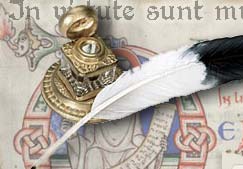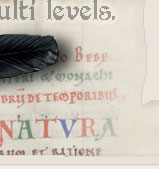|
Pages: 1 ... 5 6 7 8 9 [10]
91
« Last post by dodonovan on May 07, 2013, 01:57:00 AM »
Aaron, Interesting you should say that. I've come directly from Julian Bunn's site and it struck me that in all the effort to break the cipher, people seem to be thinking of the written text as a kind of monolithic entity - like that sculpture outside one of the sneaky-centres, forget which. I mean, they seem to forget that if the text is real, is must permit enunciation. And that means vowels. It's perfectly possible that vowels might be omitted, and if a person were used to a contemporary language omitting vowels (rather than this being a transcription from a very much earlier original) then you really don't have to worry about doing full stats, do you? The first stage would be to see whether vowel-frequencies in any particular language-group (such as Czech or Polish vs Italian) give you a comparable frequency and relative distribution? Tell me if I'm talking nonsense; I'm not an expert in languages, I'm conceptualising this more as music, imagining vowels as grace-notes of different lengths. But wouldn't that help reduce the possible number of languages, and help isolate which glyphs represented vowels - if vowels were separately represented. So then the next stage... and so on. because labels so rarely use the '4' glyph, I'd tend to omit them from the sample; I'd also tend to omit the glyphs appearing between what Nick Pelling describes as the split gallows, because I suspect it is either an invocation, or a key to the cipher or some other anomalous element. (this, by the way, because even in the Christian tradition, the customary association between plant-harvesting and star is preserved - balsam when Sirius rises sort of ting; which means that the split glyph might contain the name of plant, star, angel-of-the-month (as per the Cairo geniza and Jerusalem 'astrology'). Sorry - tmi - but yes,I'd omit those glyphs. Also, I think spaces can probably be omitted, and each paragraph treated as a 'line-length'. For reasons that would again be tmi, I think that the end-of-line glyphs are token representation of an item not required in this version. i feel a little like a tourist in a holy place here - I'll try not to make too much noise in future. (I see there is no 'modest downcast eyes' emoticon. 
92
« Last post by Aaron on May 06, 2013, 10:13:28 AM »
Yeah, it's a joke from Neon Genesis Evangelion, heh. The default tag for all newbies.
Phonetic transcription sounds like a good theory too, partly since it's not exactly a prevalent written language or anything. The question is, which language does it most approach if you sound out the words?
93
« Last post by dodonovan on May 06, 2013, 04:08:30 AM »
I've no idea how the message about the Dead Sea scrolls attached itself to my name - a joke by the great attractor, I expect.
One scenario which occurred to me and almost simultaneously to an Italian chap (whose name escapes me for the second) is that the manuscript represents the results of efforts which are recorded being made by Poggio Bracciolini to accumulate information about eastern plants. He interviewed various pilgrims but ran into problems. His translators could manage the grammar but had no equivalent in their own language or in Latin for the plant's names. Then, a bit later than the parchment's date (but not much) de' Conti arrived back from years working in the east and had certainly learned the names and virtues of eastern plants during his decades there - at least that was all he talked about according to to the Spaniard he met.
Many eastern languages are tonal or would seem so to a European - like the three positions for 'k' in Arabic.
So it is conceivable that an oral account might be taken down, with spaces left for inserting a sign indicating whether the sound was high, median, low etc. And the informant would fill those out in the fair copy.
From experience, I can assure you that it is possible for someone with a good ear to simply learn an alphabet and then be able to transcribe information dictated to them. They may not end up with perfect orthography, writing n for the formal ng or (to use an example from Japanese), writing 'mas' for the formal 'masu'.
In the imaginary scenario with de' Conti (and any number of other candidates) the script might be a simplified version of an eastern script, affected by their own native habit. A person used to writing Hebrew might square off letters; a person used to writing a European script would omit the line from which Indian scripts hang.
That would explain the interlocking 'hands', the general appearance of a writing not natural but 'drawn', and the fact that we have no other example of similar script extant (at present).
But this is just a scenario, as contra- to the current emphasis on Rugg's theory. Diane
94
Just plugging it in, I like the daiin as "IS", but not the "y" as a break.
Consider:
chol chol dar
qokchol dar
tchol dar
ykchol dar
chol daiin dar
Also consider the former problematic line:
chol chol chol cthaiin dain
If dain is "will be", we might equivalate the sentence to:
chol chol WILL BE chol cthaiin
thus neutralizing the triple word problem.
95
In regards to copy versus original work, I have a few thoughts: (a) if such works were copied directly by scribes, one would expect that this item would not be isolated; that there would be more books with a similar character set existing somewhere. None have been found, but, obviously not all are necessarily available. This is probably of some interest (I didn't pick Mali out of a vacuum): http://www.tombouctoumanuscripts.org/(b) One would expect, as a type of hand-wrought work, that the drawings would be made first, and the words made to fit around them. We have multiple instances of which the phrasing of the text seems exacting, while keeping alignment and general size. For example, Q1-F2R (p5) or Q2-F9V (p20). I believe this consistency would be difficult with a transcription. (c) The main argument for copying is there seems to be no known evidence of the writer trying to correct errors. Following through the 3 transcriptions from http://www.voynich.nu/folios.html and finding the disputed words and comparing them against the manuscript reveals that there seems to be some hesitation, and possible errors within the text, but that these were left as-is. That is, the author left any errors alone. I think those points would suggest original work.
96
Currently working through the lexicon.
"daiin" is by far the most common word, and, I'm guessing it is analogous to "is" or "to be". If so, "aiiin" and "ain" suffixes may represent tense (was, will be, or vise versa). It appears 194 times in the text and has a fairly even distribution. That's around 7.79% of words, or 9.24% of words if you include what appear to be variants, "daiiin" and "dain".
The suffixes "ol" and "or" have a strong correlation. Perhaps a gender or sum?
The character "y" is weird. It's extremely common as an ending, and occasionally used as a beginning. But as a character in the middle of a word, is extremely infrequent, happening just 6 times out of 2489 words (0.24% of words). By comparison, it starts 10.48% of words and is at the end of a staggering 46.48% of words! It may represent some sort of stop, where starting a word with it may represent the start of a new thought or "paragraph". As a check, "y" never starts a page or is the first letter after a visible break, though it occasionally precedes a footnote. You'll also notice that the "y" character has a very strong resemblance to an enclosing mark. If you follow the inkflow of the y, you would write it by making a circle motion and then moving it aside.
The thing that especially stopped me about the "y" was the appearance of the words "daiiny" and "kydainy" where I'd assume the suffixes (based on frequency) would be "aiin" and "ain", respectively, added on to "d" to make "daiin" and "kyd" to make "kydainy". Again, "daiin" is the most common word and "daiiny" happens just once, which seems to suggest a grammatical modification of the word "daiin" rather than a new word.
Just some cursory thoughts as I work on this.
97
« Last post by Aaron on April 30, 2013, 12:28:14 PM »
Good point, if these are hand-made copies we're looking at then there might be a lot of variations on the originals.
98
« Last post by dodonovan on April 30, 2013, 12:21:11 PM »
There's a constant issue with whether we're looking at an original form, or a copy of some earlier text.
Baresch did send a copy of pages to Kircher. In the relatively unlikely, but not impossible, event that he used
scrap parchment to save money on the effort - he hired at least two copyists - so we might be looking at a true copy,
but one made by people 'drawing the writing'.
That wouldn't provide much a clue to the nature of the written text as orignally formulated. If we could see that it might not
look at all like a drawing of writing, need it?
Sorry, this is probably such a basic observation that it has been made, and dealt with long ago.
D.
99
« Last post by tonybaloney on February 05, 2013, 05:31:54 PM »
I'll go with this -
Tooke excellently well purifie
bay salt dissolve or melt it
downe in some convenient vessel
over ye fier then strow some
sulphur of any mettall leasuarly up
pon it & soe by dagrees it
will melt in it & become
fusible
Tony
Pages: 1 ... 5 6 7 8 9 [10]
|





 Recent Posts
Recent Posts